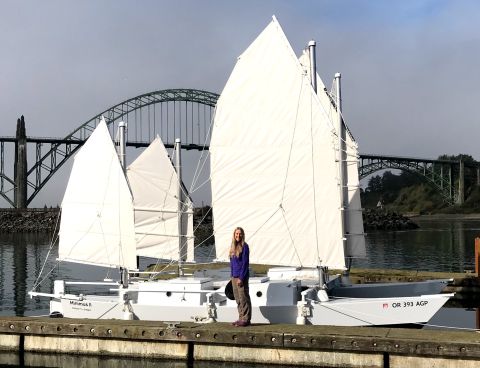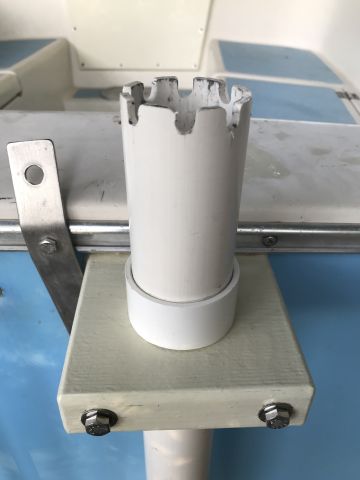
Our 24' (7.3m) cruising catamaran Minimus II with self steering mizzen.

Our Windrose 18 (5.5m) swing keel monohull with self steering mizzen.
(Updated 8-10-2021)
--Back to Adventure Page
Note: Video links at bottom of page.
 Our 24' (7.3m) cruising catamaran Minimus II with self steering mizzen. |
 Our Windrose 18 (5.5m) swing keel monohull with self steering mizzen. |
This page describes a novel approach to self steering for sailboats. In testing, it has worked well on our 24' (7.3m) cruising catamaran and on our 18' (5.5m) swing keel trailerable monohull. On both boats, the system steers within about 5 degrees either side of course on all points of sail and in a variety of wind strengths. Given it's simplicity, effectiveness and versatility, we can't imagine having a cruising sailboat without it.
A notable advantage of this system over conventional windvane or electronic self steering is that the mizzen sail can also serve a couple other purposes. When under sail, if the mizzen is not being used for self steering, it can help to balance the rig. When anchored, sheeting the mizzen amidships prevents the boat from sailing at anchor, which is an annoying tendency of most modern sailboats. This system is also much less expensive than conventional windvane self steering systems.
The basic idea is that a small mizzen sail is connected via 2 steering lines to the tiller. The mizzen sail essentially serves as a large wind vane. Although the sail is much smaller than conventional mizzens, it's quite large as compared to normal self steering wind vanes, and that's where it gets the power to effectively correct course. As long as the wind is from a consistent direction, the mizzen sail remains in line with the wind (wind-cocked). As the boat begins to veer off course, the steering lines between mizzen sail and tiller bring the boat back on course.
As with all wind self steering systems, there are two critical factors. First, the boat has to be well balanced. A small amount of weather helm is permissible, but too much will overpower the system. Second, friction in the system must be minimized.
Reducing friction in the system is easy to accomplish. We use small diameter steering lines since they develop less friction where they run through blocks than larger diameter lines would. On both boats, the steering lines are 1/8" (3mm) braided dacron. The 4 blocks required for the steering lines are small, smooth running ball bearing blocks. One of the most important ways friction is reduced is that the mizzen sail is suspended between the halyard and downhaul. This allows the mizzen sail to rotate around the mast with almost zero friction.
The system works similarly on both our catamaran and monohull. Since we've described how it works on our Minimus II cruising catamaran pages, the following description will focus on how it works on our 18' (5.5m) trailerable monohull.
The first step in building the system is to fasten a mizzen mast to the transom. Due to the small size of the mizzen sail, the loads on the mast and other components are quite low, so the mast can be much smaller diameter than on a conventional mizzen. Our mast is a 10' long (3m) piece of aluminum tube with a 2" OD (51mm) x 1/8" wall thickness (3mm). To make it easily removable for trailering, it slides into a mast socket made from a 2' (0.6m) long piece of 2" (51mm) PVC pipe. The mast socket is secured to the transom with 2 through-bolted wooden blocks. The mast slides into the PVC pipe mast socket easily and with little play. See the photos and video links below for details.
A wood cross arm with a ball bearing block on each end is secured to the mast. The cross arm is made from a piece of wood 3/4" x 1-1/2" x 2' long (19mm x 38mm x 0.6m). It's secured to the mast with through-bolted wooden blocks and wing nuts to make it easily removable for transport.
Ideally, the mizzen sail should eliminate twist as much as possible. The reason is that twist tends to retard the speed of the course correction. As twist occurs in a gust, the course correcting power of the sail happens gradually, resulting in a wider variation in course. We've found the best sail rig to be a cross between lateen and junk. It's a lateen sail in the sense that the forward ends of the yard and boom are connected, or nearly so. This results in both spars rotating at the same time, preventing twist. It can also be thought of as a junk sail in the sense that one or more battens between the boom and yard help to prevent flapping and also permit convenient reefing. This lateen/junk configuration is essentially identical to the top few panels of a modern junk sail. Similar to a junk sail, releasing the halyard drops the sail instantly into lazy jacks.
We made the 15 sq. ft. mizzen sail from 4 oz. dacron. The three wood battens are 3/4" x 1.5" x 5' long (19mm x 38mm x 1.5m). The sail is through-bolted to the battens with #10 stainless steel machine screws and fender washers. Halyard and lazy jacks are 1/4" (6mm) dacron. The mizzen sail should be cut flat, with a generous leach hollow to prevent fluttering.
For a larger boat with higher loads on the tiller, the size of mast and sail would need to be larger. On our 18' (5.5m) monohull, the weight of the rig is so small that it's easy to simply lift and rotate the mast when setting a new course. On a larger boat with a larger mizzen mast, the mast can remain stationary, with only the cross bar being rotated to set a new course.
In use, the first step is to bring the boat onto the desired course and then trim it to a neutral helm or close to it. The cross bar is then rotated to be perpendicular to the wind (either by rotating the mast on a smaller boat or rotating the cross arm on a larger boat). The mizzen sail is then raised and the steering lines led through the blocks on the cross arm, then to the opposite cockpit coaming blocks and finally to the tiller. The lines should be led so they don't touch mast, mainsheet, backstay, etc. At that point, we sit back and watch the boat go.
 Mizzen sail in self steering mode on starboard tack. Steering lines go through blocks on either end of the cross arm, then to blocks on the cockpit coaming, then to the tiller. Red lines are halyard and lazy jacks. |
 Mizzen sail in self steering mode on port tack. Note that steering lines are led so they don't touch mast, main sheet, back stay, etc. |
 Cross bar with ball bearing block on each end. Cross bar is secured to the mast with wood blocks and wing nuts to make removal Red lines are halyard and lazy jacks. Photo is during initial setup, before lines have been trimmed to length. |
 Mast head fitting made from 2" (51mm) PVC pie and pipe cap. PVC pipe and cap are free to rotate on top of aluminum mast. |
 Ball bearing block on port cockpit coaming. The steering lines are secured to the tiller with quick release knots. For more convenience, 2 small clam cleats will be mounted on top of the tiller to make securing the steering lines quicker and easier. |
 2" (51mm) OD aluminum mast slides inside 2" (51mm) PVC pipe which is secured to transom with through-bolted wood blocks. The top of the PVC pipe is slotted to accept an aluminum key which is secured to the mast with hose clamps. In use, it's important that the cross bar faces the wind. To do this, the mast is lifted slightly, rotated into position and lowed into one of the 8 slots. |
 View of mizzen mast socket on transom from below |
 Closeup of 2" (51mm) PVC pipe mizzen mast socket. The collar on top of the block prevents the pipe from sliding downward. It's cut from a 2" (51mm) PVC coupling, then slid down the pipe and glued in place. |
 We used two mast sockets to give more flexibility on courses where the back stay might interfere with the mizzen sail. On most points of sail, or on boats without a backstay, it isn't necessary to have 2 sockets. |
The videos below are somewhat redundant to hopefully make the system as understandable as possible.
--Video #1 of 9: A monohull sailboat self steering under mizzen sail while close hauled in a 12-15 knot wind.
--Video #2 of 9: A monohull sailboat self steering under mizzen sail on broad reach in light wind. Showing mizzen sail correcting course.
--Video #3 of 9: A monohull sailboat self steering under mizzen sail close hauled in 8-10 knot wind.
--Video #4 of 9: A monohull sailboat self steering under mizzen sail on broad reach.
--Video # 5 of 9: A monohull sailboat self steering under mizzen sail on broad reach in 5-8 knot wind.
--Video # 6 of 9: Explanation of mizzen sail self steering.
--Video # 7 of 9: Explanation of mizzen sail self steering.
--Video # 8 of 9: Explanation of mizzen sail self steering.
--Video # 9 of 9: Explanation of mizzen sail self steering.